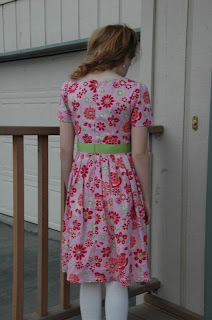But anyway...on to the Everyday Skirt.
Pattern can be purchased here.
This pattern is the size of a small greeting card and holds all the necessary information to make a really cute skirt. I could certainly figure out how to make this skirt on my own without the pattern but, WHY?! She has everything all figured out for me. I don't have to do any math. The black and white pictures are sufficient to help understand her directions. All in all it is a nice simple pattern with great results.
My daughter thought these two fabrics together were Matilda Jane-esque.
I wanted to give a couple of helpful suggestions with pictures for this pattern.
She has you cut out your main skirt fabric as a two large rectangles. Then you measure over 4" from each side.
Next, cut a diagonal line from the mark to the bottom corner.
Do this on both sides so the finished product looks like this:
I then folded the fabric in half to make sure the sides were mirror images.
Obviously, this technique could apply to any A-lined skirt.
Next hint: The waist band is attached a little differently. She has you place the Right side of the Waistband against the Wrong side of the Skirt. The picture below shows this. After stitching flip the waistband to the right side and stitch down. Not the way I would normally do this but it has a nice finished look.
The rest of the pattern is pretty easy to follow so on to the hem band.
In the pattern you are to add the band and sew a narrow hem to finish. But, I don't love the look of a bottom band with a narrow hem.
This band is perfectly acceptable. I just don't love the line of stitching at the bottom for the narrow hem. To me, it looks like too many lines of stitching. I know that from far away it isn't even noticeable but I notice it and so I like to eliminate it.
You will have to do a little math for this. I know, this takes away a bit of the simplicity I loved about this pattern but for me the finished result is worth it.
In the pattern you are to cut the band 2 3/4" wide. There is a 1/4" seam allowance attaching to the skirt and 1/2" for the narrow hem. This leaves a 2" finished band.
I want a similar 2" finished band. Since I want it finished on both sides I need to add another 2" for the inside and 1/4" seam allowance for both sides. My new bands needs to be cut 4 1/2" wide.
Cut two bands and iron them in half, wrong sides together.
I personally prefer to iron flat pieces so I seamed the two pieces together after and ironed the portions by the seam again. Feel free to seam the two pieces together and then iron in half if you prefer.
Your finished product should be a large circle with the right side on both sides.
Pin on side of the hem band to the right side of the skirt, raw edges together. Stitch.
Press the seam allowance toward the skirt.
Edgestitch close to the seam. You can faintly see the black line of stitching just above the band.
Now you have a finished skirt with only one seam at the bottom, finished inside and out. Beautiful!
A couple shots on my little model.
Have a great day!
Until next time...












